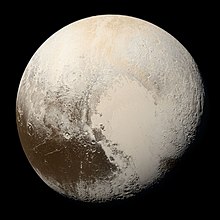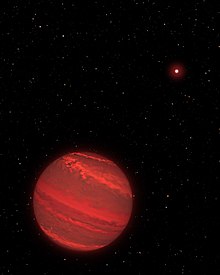
A planetary-mass object (PMO), planemo, or planetary body (sometimes referred to as a world) is, by geophysical definition of celestial objects, any celestial object massive enough to achieve hydrostatic equilibrium, but not enough to sustain core fusion like a star.
The purpose of this term is to classify together a broader range of celestial objects than 'planet', since many objects similar in geophysical terms do not conform to conventional expectations for a planet. Planetary-mass objects can be quite diverse in origin and location. They include planets, dwarf planets, planetary-mass satellites and free-floating planets, which may have been ejected from a system (rogue planets) or formed through cloud-collapse rather than accretion (sub-brown dwarfs).
Usage in astronomy
While the term technically includes exoplanets and other objects, it is often used for objects with an uncertain nature or objects that do not fit in one specific class. Cases in which the term is often used:
- isolated planetary-mass objects (iPMO; IPMO) are objects that are free-floating and have a low mass below deuterium burning and their nature as either an ejected free-floating planets or sub-brown dwarfs is not fully resolved (e.g. 2MASS J13243553+6358281, PSO J060.3200+25.9644 objects in NGC 1333)
- Objects with a mass range at the border of deuterium burning (VHS 1256-1257 b, BD+60 1417b)
- Objects that orbit a star or brown dwarf, but its formation as exoplanets is challenging or impossible (VHS 1256-1257 b, CFHTWIR-Oph 98B)
Types
Planetary-mass satellite
Main article: Planetary-mass moon
The three largest satellites Ganymede, Titan, and Callisto are of similar size or larger than the planet Mercury; these and four more – Io, the Moon, Europa, and Triton – are larger and more massive than the largest and most massive dwarf planets, Pluto and Eris. Another dozen smaller satellites are large enough to have become round at some point in their history through their own gravity, tidal heating from their parent planets, or both. In particular, Titan has a thick atmosphere and stable bodies of liquid on its surface, like Earth (though for Titan the liquid is methane rather than water). Proponents of the geophysical definition of planets argue that location should not matter and that only geophysical attributes should be taken into account in the definition of a planet. The term satellite planet is sometimes used for planet-sized satellites.
Dwarf planets

A dwarf planet is a planetary-mass object that is neither a true planet nor a natural satellite; it is in direct orbit of a star, and is massive enough for its gravity to compress it into a hydrostatically equilibrious shape (usually a spheroid), but has not cleared the neighborhood of other material around its orbit. Planetary scientist and New Horizons principal investigator Alan Stern, who proposed the term 'dwarf planet', has argued that location should not matter and that only geophysical attributes should be taken into account, and that dwarf planets are thus a subtype of planet. The International Astronomical Union (IAU) accepted the term (rather than the more neutral 'planetoid') but decided to classify dwarf planets as a separate category of object.
Planets and exoplanets
These paragraphs are an excerpt from Planet. A planet is a large, rounded astronomical body that is generally required to be in orbit around a star, stellar remnant, or brown dwarf, and is not one itself. The Solar System has eight planets by the most restrictive definition of the term: the terrestrial planets Mercury, Venus, Earth, and Mars, and the giant planets Jupiter, Saturn, Uranus, and Neptune. The best available theory of planet formation is the nebular hypothesis, which posits that an interstellar cloud collapses out of a nebula to create a young protostar orbited by a protoplanetary disk. Planets grow in this disk by the gradual accumulation of material driven by gravity, a process called accretion.Former stars
See also: Disrupted planet § StarsIn close binary star systems, one of the stars can lose mass to a heavier companion. Accretion-powered pulsars may drive mass loss. The shrinking star can then become a planetary-mass object. An example is a Jupiter-mass object orbiting the pulsar PSR J1719−1438. These shrunken white dwarfs may become a helium planet or carbon planet.
Sub-brown dwarfs
Main article: Sub-brown dwarf
Stars form via the gravitational collapse of gas clouds, but smaller objects can also form via cloud collapse. Planetary-mass objects formed this way are sometimes called sub-brown dwarfs. Sub-brown dwarfs may be free-floating such as Cha 110913−773444 and OTS 44, or orbiting a larger object such as 2MASS J04414489+2301513.
Binary systems of sub-brown dwarfs are theoretically possible; Oph 162225-240515 was initially thought to be a binary system of a brown dwarf of 14 Jupiter masses and a sub-brown dwarf of 7 Jupiter masses, but further observations revised the estimated masses upwards to greater than 13 Jupiter masses, making them brown dwarfs according to the IAU working definitions.
Captured planets
Rogue planets in stellar clusters have similar velocities to the stars and so can be recaptured. They are typically captured into wide orbits between 100 and 10 AU. The capture efficiency decreases with increasing cluster volume, and for a given cluster size it increases with the host/primary mass. It is almost independent of the planetary mass. Single and multiple planets could be captured into arbitrary unaligned orbits, non-coplanar with each other or with the stellar host spin, or pre-existing planetary system.
Rogue planets
Main article: Rogue planet See also: Five-planet Nice modelSeveral computer simulations of stellar and planetary system formation have suggested that some objects of planetary mass would be ejected into interstellar space. Such objects are typically called rogue planets.
See also
- Planetary mass
- List of gravitationally rounded objects of the Solar System
- List of Solar System objects by size
References
- Brown, Michael E.; Butler, Bryan (July 2023). "Masses and densities of dwarf planet satellites measured with ALMA". The Planetary Science Journal. 4 (10): 11. arXiv:2307.04848. Bibcode:2023PSJ.....4..193B. doi:10.3847/PSJ/ace52a.
- Weintraub, David A. (2014). Is Pluto a Planet?: A Historical Journey through the Solar System. Princeton University Press. p. 226. ISBN 978-1400852970.
- Basri, Gibor; Brown, E. M. (May 2006). "Planetesimals to Brown Dwarfs: What is a Planet?". Annual Review of Earth and Planetary Sciences. 34: 193–216. arXiv:astro-ph/0608417. Bibcode:2006AREPS..34..193B. doi:10.1146/annurev.earth.34.031405.125058. S2CID 119338327.
- Stern, S. Alan; Levison, Harold F. (2002). Rickman, H. (ed.). "Regarding the criteria for planethood and proposed planetary classification schemes". Highlights of Astronomy. 12. San Francisco, CA: Astronomical Society of the Pacific: 208. Bibcode:2002HiA....12..205S. doi:10.1017/S1539299600013289. ISBN 978-1-58381-086-6.
- Gagné, Jonathan; Allers, Katelyn N.; Theissen, Christopher A.; Faherty, Jacqueline K.; Bardalez Gagliuffi, Daniella; Artigau, Étienne (2018-02-01). "2MASS J13243553+6358281 Is an Early T-type Planetary-mass Object in the AB Doradus Moving Group". The Astrophysical Journal. 854 (2): L27. arXiv:1802.00493. Bibcode:2018ApJ...854L..27G. doi:10.3847/2041-8213/aaacfd. ISSN 0004-637X.
- Best, William M. J.; Liu, Michael C.; Magnier, Eugene A.; Bowler, Brendan P.; Aller, Kimberly M.; Zhang, Zhoujian; Kotson, Michael C.; Burgett, W. S.; Chambers, K. C.; Draper, P. W.; Flewelling, H.; Hodapp, K. W.; Kaiser, N.; Metcalfe, N.; Wainscoat, R. J. (2017-03-01). "A Search for L/T Transition Dwarfs with Pan-STARRS1 and WISE. III. Young L Dwarf Discoveries and Proper Motion Catalogs in Taurus and Scorpius-Centaurus". The Astrophysical Journal. 837 (1): 95. arXiv:1702.00789. Bibcode:2017ApJ...837...95B. doi:10.3847/1538-4357/aa5df0. ISSN 0004-637X.
- Scholz, Aleks; Muzic, Koraljka; Jayawardhana, Ray; Almendros-Abad, Victor; Wilson, Isaac (2023-05-01). "Disks around Young Planetary-mass Objects: Ultradeep Spitzer Imaging of NGC 1333". The Astronomical Journal. 165 (5): 196. arXiv:2303.12451. Bibcode:2023AJ....165..196S. doi:10.3847/1538-3881/acc65d. ISSN 0004-6256.
- Miles, Brittany E.; Biller, Beth A.; Patapis, Polychronis; Worthen, Kadin; Rickman, Emily; Hoch, Kielan K. W.; Skemer, Andrew; Perrin, Marshall D.; Whiteford, Niall; Chen, Christine H.; Sargent, B.; Mukherjee, Sagnick; Morley, Caroline V.; Moran, Sarah E.; Bonnefoy, Mickael (2023-03-01). "The JWST Early-release Science Program for Direct Observations of Exoplanetary Systems II: A 1 to 20 μm Spectrum of the Planetary-mass Companion VHS 1256-1257 b". The Astrophysical Journal. 946 (1): L6. arXiv:2209.00620. Bibcode:2023ApJ...946L...6M. doi:10.3847/2041-8213/acb04a. ISSN 0004-637X.
- Faherty, Jacqueline K.; Gagné, Jonathan; Popinchalk, Mark; Vos, Johanna M.; Burgasser, Adam J.; Schümann, Jörg; Schneider, Adam C.; Kirkpatrick, J. Davy; Meisner, Aaron M.; Kuchner, Marc J.; Bardalez Gagliuffi, Daniella C.; Marocco, Federico; Caselden, Dan; Gonzales, Eileen C.; Rothermich, Austin (2021-12-01). "A Wide Planetary Mass Companion Discovered through the Citizen Science Project Backyard Worlds: Planet 9". The Astrophysical Journal. 923 (1): 48. arXiv:2112.04678. Bibcode:2021ApJ...923...48F. doi:10.3847/1538-4357/ac2499. ISSN 0004-637X.
- Fontanive, Clémence; Allers, Katelyn N.; Pantoja, Blake; Biller, Beth; Dubber, Sophie; Zhang, Zhoujian; Dupuy, Trent; Liu, Michael C.; Albert, Loïc (2020-12-01). "A Wide Planetary-mass Companion to a Young Low-mass Brown Dwarf in Ophiuchus". The Astrophysical Journal. 905 (2): L14. arXiv:2011.08871. Bibcode:2020ApJ...905L..14F. doi:10.3847/2041-8213/abcaf8. ISSN 0004-637X.
- Villard, Ray (2010-05-14). "Should Large Moons Be Called 'Satellite Planets'?". Discovery News. Archived from the original on 2010-05-16. Retrieved 2011-11-04.
- "Resolution B5 Definition of a Planet in the Solar System" (PDF). IAU 2006 General Assembly. International Astronomical Union. Retrieved January 26, 2008.
- Lecavelier des Etangs, A.; Lissauer, Jack J. (1 June 2022). "The IAU working definition of an exoplanet". New Astronomy Reviews. 94: 101641. arXiv:2203.09520. Bibcode:2022NewAR..9401641L. doi:10.1016/j.newar.2022.101641. ISSN 1387-6473. S2CID 247065421. Archived from the original on 13 May 2022. Retrieved 13 May 2022.
- Bailes, M.; Bates, S. D.; Bhalerao, V.; Bhat, N. D. R.; et al. (2011). "Transformation of a Star into a Planet in a Millisecond Pulsar Binary". Science. 333 (6050): 1717–20. arXiv:1108.5201. Bibcode:2011Sci...333.1717B. doi:10.1126/science.1208890. PMID 21868629. S2CID 206535504.
- "Artist's View of a Super-Jupiter around a Brown Dwarf (2M1207)". ESA/Hubble. 19 February 2016. Archived from the original on Apr 17, 2021. Retrieved 22 February 2016.
- Luhman, K. L.; Adame, Lucía; D'Alessio, Paola; Calvet, Nuria (2005). "Discovery of a Planetary-Mass Brown Dwarf with a Circumstellar Disk". Astrophysical Journal. 635 (1): L93. arXiv:astro-ph/0511807. Bibcode:2005ApJ...635L..93L. doi:10.1086/498868. S2CID 11685964.
- Whitney Clavin (2005-11-29). "A Planet With Planets? Spitzer Finds Cosmic Oddball". NASA (Press release). Archived from the original on 2012-10-11. Retrieved 2022-07-29.
- Joergens, V.; Bonnefoy, M.; Liu, Y.; Bayo, A.; et al. (2013). "OTS 44: Disk and accretion at the planetary border". Astronomy & Astrophysics. 558 (7): L7. arXiv:1310.1936. Bibcode:2013A&A...558L...7J. doi:10.1051/0004-6361/201322432. S2CID 118456052.
- Close, Laird M.; Zuckerman, B.; Song, Inseok; Barman, Travis; et al. (2007). "The Wide Brown Dwarf Binary Oph 1622–2405 and Discovery of A Wide, Low Mass Binary in Ophiuchus (Oph 1623–2402): A New Class of Young Evaporating Wide Binaries?". Astrophysical Journal. 660 (2): 1492–1506. arXiv:astro-ph/0608574. Bibcode:2007ApJ...660.1492C. doi:10.1086/513417. S2CID 15170262.
- Luhman, Kevin L.; Allers, Katelyn N.; Jaffe, Daniel T.; Cushing, Michael C.; Williams, Kurtis A.; Slesnick, Catherine L.; Vacca, William D. (April 2007). "Ophiuchus 1622-2405: Not a Planetary-Mass Binary". The Astrophysical Journal. 659 (2): 1629–1636. arXiv:astro-ph/0701242. Bibcode:2007ApJ...659.1629L. doi:10.1086/512539. S2CID 11153196.
- Britt, Robert Roy (2004-09-10). "Likely First Photo of Planet Beyond the Solar System". Space. Archived from the original on Jan 27, 2011. Retrieved 2008-08-23.
- On the origin of planets at very wide orbits from the re-capture of free floating planets Archived 2022-04-12 at the Wayback Machine, Hagai B. Perets, M. B. N. Kouwenhoven, 2012
- Lissauer, J. J. (1987). "Timescales for Planetary Accretion and the Structure of the Protoplanetary disk". Icarus. 69 (2): 249–265. Bibcode:1987Icar...69..249L. doi:10.1016/0019-1035(87)90104-7. hdl:2060/19870013947.